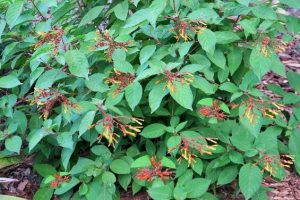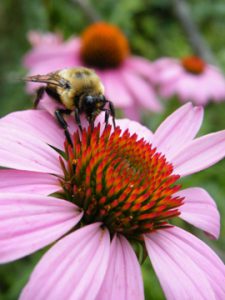During the pandemic, 4-H youth development professionals have had to think out-of-the-box to present educational programs to the youth of Florida. Hence, Florida 4-H Adventures (http://florida4h.org/programsandevents_/4-h-adventures/) – an amazing offering of virtual day camps through Google Suites on a wide array of topics.
One of these camps was called ‘Beautiful Invaders and Native Beauties.’ It focused on invasive and native plants in Florida. Taught by Dr. Marnie Ward, Ms. Lara Colley, and Mrs. Laura Cash, the five day camp kept the participants actively engaged by providing daily Zoom sessions and time to work on their own through the website activities and lessons.

After defining essential terms like exotic, naturalized, invasive, noxious and native, we moved on to morphology. Morphology is defining species by characteristics, such as the edges of leaves, types of venation, and flower type. By being able to recognize invasive species, we can work to find and control or eradicate them.
Each day, we visited either backyards, uplands, or wetlands. We were able to predict what invasive species we would find in each environment. In our yards, we found air potato, sword fern, coral ardisia, cat’s claw vine, mimosa trees, camphor trees, and creeping oxeye – just to name a few. In our uplands we found kudzu, Brazilian pepper, old world climbing fern, skunkvine, cogongrass, and melaleuca. Wetlands are plagued with water hyacinths, water spinach, giant salvinia, and hydrilla. With videos, interviews, and other educational resources, we were able to show the youth how invasive plants are devastating our state.

With few predators, a warm climate, and the ability to propagate quickly, invasive species are crowding out our native plants. Big problems result! They are creating monocultures: environments with one species. Plants like water lettuce and wild taro can clog up waterways. Tiger swallowtail butterflies do not know that caesarweed is not native – to them it is simply a food source. To Carolina wrens, a Brazilian pepper berry is food. To other wildlife and livestock, however, some invasive plants can be deadly. When cedar waxwings eat nandina berries or cattle eat lantana and tropical soda apple, the animals die or become very ill. Furthermore, invasive plants lack the nutritional value of native species and some animals are completely dependent upon specific habitats and plant life.
Our last day was spent on Native Beauties – plants like beautyberry, frogfruit, wiregrass, tickseed, firebush, and other treasures that support our Florida ecosystems.
In order to encourage our youth to be active citizens, we introduced them to IveGot1, an app through EDDMaps, to report invasive species of all sorts. Other apps are out there too, like Picture This and iNaturalist’s Seek – to identify animals, insects, and plants.

Our goal was to make the youth more aware of their environment and to inspire them to make a difference. Public service announcements, crafts, transects, and plans to create backyard wildlife habitats are just a few examples of what these remarkable youth accomplished.
Find out more: https://plants.ifas.ufl.edu/
Florida Invasive Plant Education Initiative Coordinator
Marnie Ward, Ph.D.
4-H Youth Development Agent II UF/IFAS Extension Citrus County
mlward@ufl.edu
 0
0
